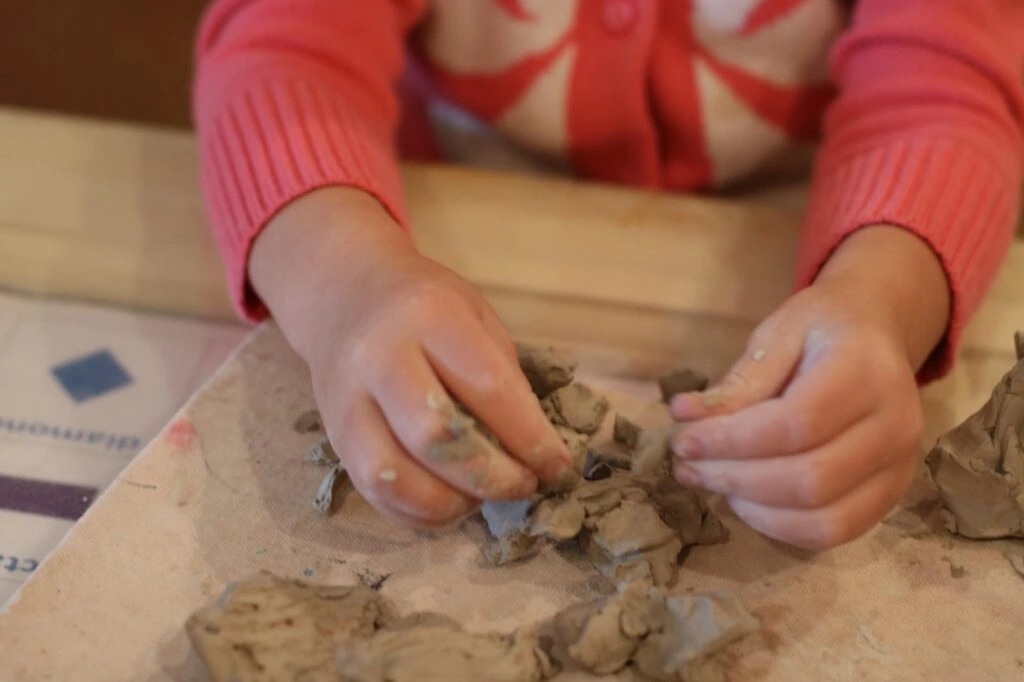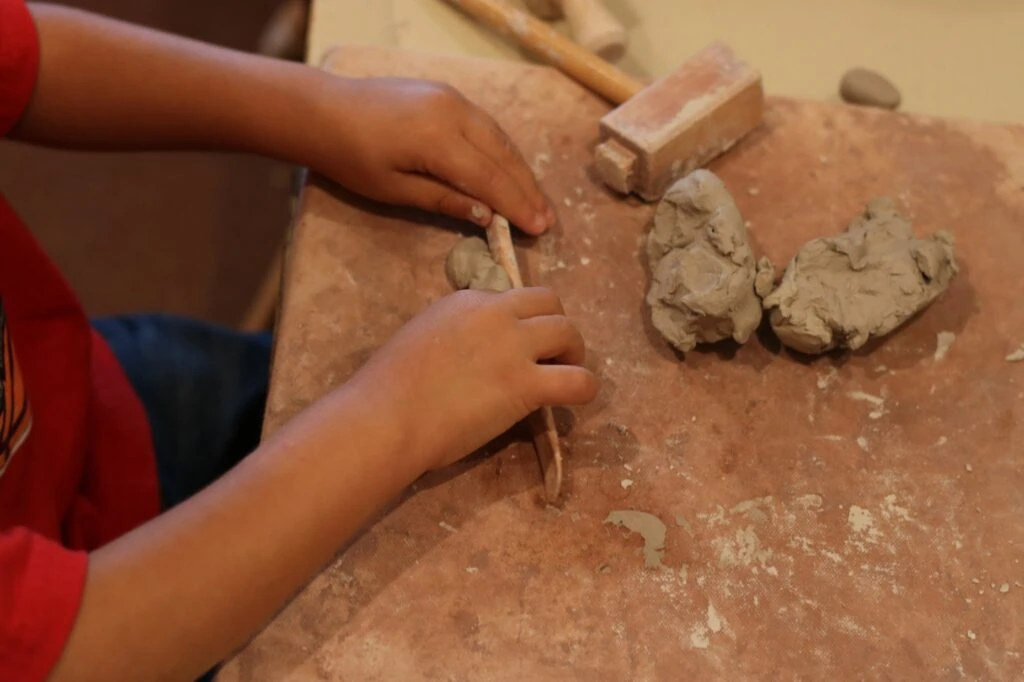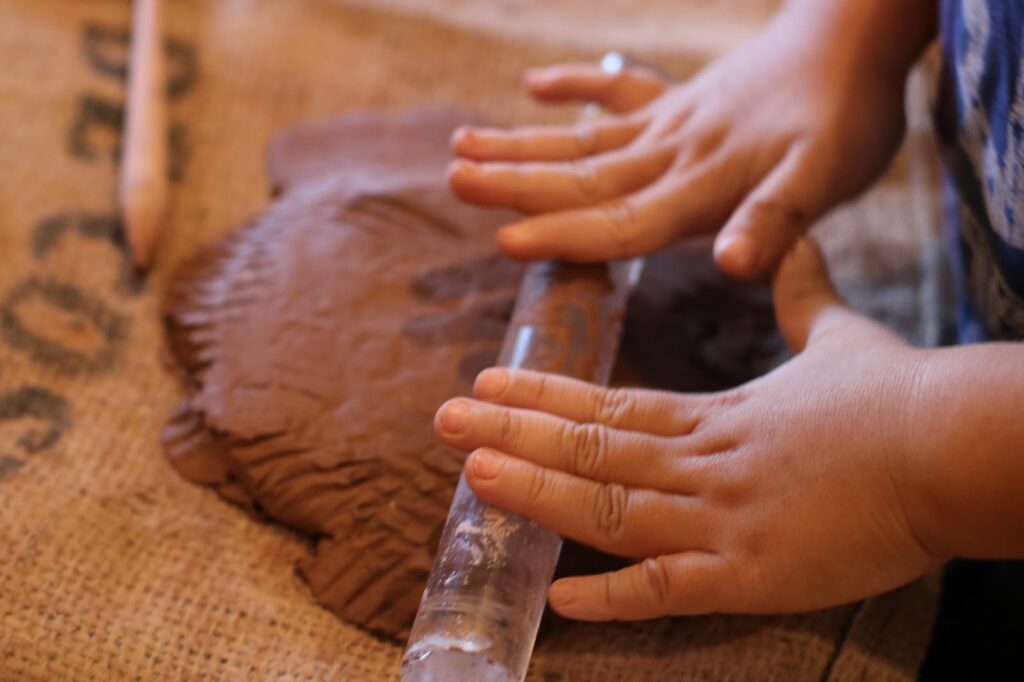How many times have you jumped directly to the “create and make” stage when introducing a new material? Yet it’s in the exploration stage that children discover the wonder and magic of materials.
So it makes sense to let them linger in the “explore” stage — and fortunately, clay is a perfect medium for this! Read on to find out why, and discover the exciting stages and benefits of bringing clay play to your classroom.

Oh, the language of clay!
Clay is a naturally occurring substance that comes from the earth. One of the magical qualities of clay is how responsive it is to our manipulations. And, different from playdough, the earthy aroma of clay activates all the senses.
Like other art forms, the child brings their developmental needs to clay. Let the children explore the clay and bring their own curiosity. The clay will obey the child with great respect!
Playing with clay should be a regular opportunity for young children. Some centers have even adopted clay tables dedicated to the exploration of clay. When using clay on tables, it is important to set it up properly so you can minimize the clean up.
Top tip: go to your local fabric shop and buying burlap to cover your table. Burlap is an ideal surface for clay play!

Keep the wonder alive
Asking “What are you making” can take children out of the explore stage. It is a product-driven question that sets the expectation of the child creating “something”.
Keep children’s wonder alive by sticking to open ended wonderings.

Exploration Wonderings:
- What do you notice about the clay?
- I wonder how it feels?
- How can you get it off the big block?
- I wonder how we can stick the pieces together?
- What happens when you add water?
- Tell me about how it smells…feels…sounds…even tastes!
Actions we observe in each stage of clay play
1. Touching & Discovering

This stage is all about exploring the tactile qualities of clay. Children use their fingers and hands to squeeze, pinch, poke, and prod the clay, discovering its texture and malleability. This stage helps children develop fine motor skills and spatial awareness, as well as an appreciation for the material itself.
2. Piling

Piling clay into different shapes and forms is a fun way for children to experiment with balance and stability. This stage also encourages children to think creatively about how they can use different forms and shapes to create interesting compositions and designs. The simple task of piling turns into building tall and problem-solving to make it stay.
3. Pounding

The act of pounding is a fabulous way to let the need to use force be met! Pounding clay with hands or tools helps children develop gross motor skills and strength. This stage is all about exploring the physical properties of clay and experimenting with different forms of manipulation. Children may also enjoy making imprints or marks on the clay using their fists or other objects.
4. Cutting

Cutting clay with tools or utensils introduces children to basic shapes and patterns, as well as the concept of division and subtraction. It’s also an amazing exercise to develop fine motor skills and build those muscles for writing. This stage encourages children to think creatively about how they can transform a solid block of clay into something new and interesting.
5. Rolling

Rolling clay into balls or ropes is a natural progression from finger and hand play. Children learn to apply pressure and control their movements to create different shapes and sizes. This stage can also involve experimenting with different tools, such as rolling pins and cardboard tubes, or textured objects like cans and wooden dowels, to create unique patterns and textures.
Addition of Loose Parts

Adding loose parts to clay, such as sticks, stones, or buttons, can be a fun way for children to experiment with texture and dimensionality. A simple jam jar lid can provide a vast extension to the explore stage in clay. This stage encourages children to think outside the box and use their imaginations to create unique and interesting sculptures.
Benefits of Exploring Clay
Working with clay…
- Engages all the senses, giving children the sensory experiences they so desperately need;
- Develops their fine motor skills, hand-eye coordination, and spatial awareness;
- Provides opportunities for storytelling and to develop language and communication skills, as well as promoting cognitive development;
- Helps children develop problem-solving skills by experimenting with different shapes, sizes, and forms of clay;
- Builds a child’s ability to focus and concentrate as they work to mold and shape the clay into their desired form;
- Ignites the children’s curiosity about the natural world, and the properties of different materials and how they interact with each other;
- Allows for a natural progression in the developmental stages with materials;
- Provides a calming and relaxing activity as children manipulate the clay;
- Can serve as a powerful tool for self-expression, allowing children to communicate their thoughts, feelings, and ideas in a nonverbal way;
- Fosters an understanding of basic scientific concepts, such as texture, shape, and form;
- Can be a social activity, providing opportunities for children to share their ideas, collaborate, and learn from one another.
And so much more!
Let’s foster the explore stage with materials in our classrooms!
Let them linger and wonder a bit longer.
References
Bartel, Marvin (2006) Clay for Toddlers and Preschoolers – How and Why
Myrnawati, Dinar Indrasati; Handini, Crie. (2018). Increasing Creativity Through Clay. International Journal of Latest Research in Humanities and Social Science (IJLRHSS) Volume 01 – Issue 10, PP. 39-45.
Pacini-Ketchabaw, Veronica; Kind, Syliva; Kocher, Laurie (2017). Encounters with Materials in Early Childhood Education. Routledge, New York.
Topal, Cathy Weisman (1998). Children, Clay, And Sculpture. Davis.
You might also be interested to read our blog post about the exploration stage of paint.



